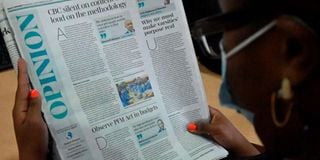Why plagiarism in journalism is a sin which cannot be washed away

A newspaper fan reads the Opinion section of the ‘Daily Nation’.
What you need to know:
- Plagiarism compromises a newspaper’s honesty, accuracy and accountability.
- It can also erode readers’ trust because it misleads them to believe the material is new, fresh and original.
Plagiarism — copying other writers’ words and images and passing them off as your own — is an unforgivable sin in journalism. It is theft of intellectual property and, although it’s not a crime, has severe moral, ethical and legal implications.
The NMG editorial policy regards plagiarism as “a serious ethical breach”. Readers may recall when the Daily Nation, on October 23, 2014, published a plagiarised picture of two lambs suckling a cow. The picture, taken in New Zealand, was “lifted” from the internet. It was subsequently submitted to the Nation as a genuine photograph taken at a farm in Chepkeche, Uasin Gishu County.
Declaring that NMG enforces a policy of strict zero tolerance to plagiarism, the Nation apologised to the owner of the photo, saying it had taken appropriate administrative action against the plagiarist. “We are sorry for having misled our readers and assure them of improved vigilance to avoid recurrence of such errors,” it further stated.
Plagiarism compromises a newspaper’s honesty, accuracy and accountability. It can also erode readers’ trust because it misleads them to believe the material is new, fresh and original. At the same time, it violates the intellectual property rights of other writers and publishers.
Serial plagiarist
Some six years ago, a former NMG journalist wrote asking me questions that are still valid today: “How does NMG allow its writers to pass off other people’s articles as their own? What quality control systems does NMG have to enforce its zero tolerance to plagiarism?”
He suggested that NMG invest in an anti-plagiarism software and require editors to first run articles through it to confirm originality. I picked up the suggestion and ran it through the Editor-in-Chief. He bought the idea of enabling editors to catch plagiarised articles before they are published. However, some still manage to slip through because editors don’t always use the software.
It’s the readers, in fact, who are the real plagiarism police. It’s through their vigilance that most of the cheats are caught. Recently, a reader drew my attention to a columnist whose writing was suspect. Upon checking, it became evident that the columnist was a serial plagiarist whose plagiarised articles have routinely escaped the attention of editors. Some of his articles are over 80 per cent plagiarised. This is the most egregious example of plagiarism I’ve ever encountered.
The columnist is the Nation equivalent of Jayson Blair, the New York Times serial plagiarist unearthed in 2003 and whose name has become a synonym for plagiarism. A Texas newspaper noticed similarities between a column by Blair and the writings of one of its reporters. The Times investigated the claim and discovered that Blair had plagiarised at least 36 of his 73 articles.
I have in the past six years written eight articles in this column on plagiarism. In the last one, just over two years ago, I pointed out that there must be a reasonable basis for claiming that an article is plagiarised (“Did archbishop plagiarise reader’s proposal on how to win graft war?” (Daily Nation, August 22, 2019).
Professional misconduct
Plagiarism takes many forms and varies in significance. The most concerning is the deliberate and direct copying of another writer’s work without acknowledgment. In contrast, there is unintentional copying, where one fails to put borrowed words in quotation marks or properly acknowledge a source. Another form of significant plagiarism is patchwork plagiarism — copying text from multiple sources and passing it off as one’s own.
But in all cases what matters most is the index, or percentage, of the copied text. Less than 15 per cent, especially of commonly used words or common information, is not considered significant unless the copied words form a block or continuous sentences.
Intentional plagiarism is a sin that can’t be washed away because journalism must always be seen to be honest, transparent and accountable. A writer who undermines those tenets of journalism by plagiarising, most editors agree, must be gotten rid of.
The Blair case is a lesson to all editors. It shows how professional misconduct can occur even in a newspaper regarded as a custodian of journalistic standards. It also shows what can happen if editors are not vigilant.
The Public Editor is an independent news ombudsman who handles readers’ complaints on editorial matters including accuracy and journalistic standards. Email: [email protected]. Call or text 0721989264.





